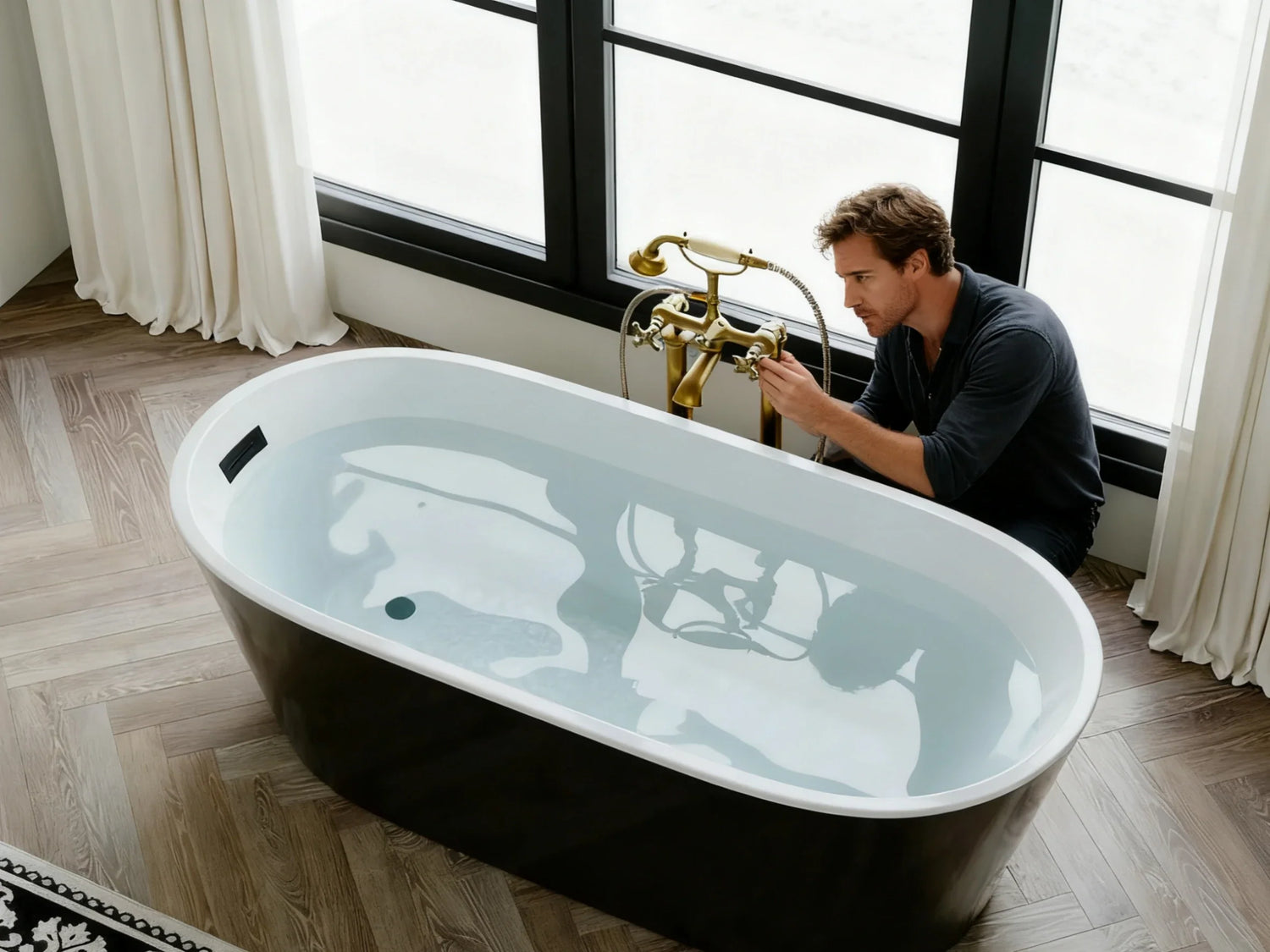How to Fix Tub Faucet: Quick-Start Checklist
Shut off water and prep the workspace
- Turn off the water supply. If your bathroom has local shutoffs, use them. If not, turn off the main.
- Open the faucet to relieve pressure and drain the lines.
- Cover the tub with a towel or thick cloth to protect the surface and catch small parts.
- Place a rag in the drain so screws and clips don't fall in.
- Verify water is off by trying the handle again. No flow? You're ready.
Identify your faucet type in 60 seconds
- Single handle that turns left/right for temp and up/down for flow: That's usually a cartridge or ceramic disc type.
- Two separate handles (hot and cold): Often a compression type with rubber washers and possibly threaded stems.
- A round cap with an inner ball and springs: That's a ball-type valve.
- Not sure: Look at the escutcheon (trim plate) and valve shape behind the wall when the handle is off. The internal part often gives it away.

Tools and materials checklist
- Adjustable wrench
- Allen (hex) key set
- Philips and flat screwdrivers
- Needle-nose pliers
- Replacement cartridge, washers, seats, springs, and O-rings (match your model)
- Silicone plumber's grease (for O-rings; not petroleum)
- Plumber's tape (for threaded spout connections)
- Penetrating oil (for stuck set screws or trim)
- Non-marring handle puller (optional but helpful)
- Clean rags and a small bowl for parts
Fix Tub Faucet: Diagnose the Problem Fast
Symptom-to-cause table
| Symptom at the tub spout or handle | Likely cause | What to fix |
| Constant drip from the spout | Worn cartridge, washer, or seat | Replace cartridge OR washer/seat; inspect O-rings |
| Leak only on hot or only on cold | That side's internal seal worn | Replace that side's stem/cartridge and matching parts |
| Water at bottom of the spout (near wall) | Spout O-ring or loose set screw | Replace spout O-ring; tighten or reset spout |
| Poor flow or low pressure | Sediment in cartridge/disc/ball, clogged diverter | Clean or replace internal parts; flush lines |
| Handle hard to turn or sticks | Mineral scale, dry O-rings | Clean parts; grease O-rings; replace worn items |
| Temperature swings or scald risk | Mis-set temperature limiter or pressure balance issue | Recalibrate scald guard; inspect balancing parts |
| Water comes from shower head when filling tub | Diverter stuck or worn | Clean or replace diverter in the spout or valve |
Guided diagnostic quiz to pinpoint "leaky bathtub faucet" root cause
Ask yourself:
Is the drip hot, cold, or both?
Turn off the hot water supply only, then test. If the drip stops, the hot side is the cause. If it keeps dripping, check the cold side.
Does the drip change when you move the handle slightly?
That points to a worn cartridge surface or washer.
That suggests an O-ring at the tub spout.
Sediment may be the issue.
Hot vs. cold leak identification and diverter checks

Fix Tub Faucet: Step-by-Step Repairs by Faucet Type
Cartridge faucets: 8-step replacement
- Turn off water and prep the tub.
- Remove the handle. Find the small cover cap, loosen the set screw with an Allen key, and pull the handle straight off. If tight, wiggle gently or use a puller.
- Remove trim: unscrew the faceplate and gently pull off the escutcheon. Keep track of screws.
- Remove any retaining clip or nut holding the cartridge. Use needle-nose pliers for clips.
- Note orientation. Many cartridges have a "hot" side marking or tabs. Take a photo so you can put the new one in the same way.
- Pull the old cartridge straight out. If stuck, apply penetrating oil, twist gently, and pull. Avoid prying against the wall or bending soft plastic.
- Lube the new O-rings with a light film of silicone grease. Insert the new cartridge in the same orientation. Reinstall the retaining clip or nut until it seats with a firm "snap" or snug fit. Do not over-tighten.
- Reassemble trim and handle. Turn water on slowly. Check for leaks. If the water is too hot, adjust the temperature limiter (scald guard) per your valve's design, so the bath stays safe.
Compression faucets: Replace washers, seats, and springs
- Shut off water. Remove hot and cold handles.
- Unscrew the chrome bonnet nut or retaining nut. Pull out the stem.
- Inspect the rubber washer at the tip. If it's grooved, brittle, or missing, that's your leak.
- Replace the washer and screw. Match the washer size and style. Apply a small dab of silicone grease to the O-ring on the stem.
- Check the valve seat deep in the body. If it's pitted, use a seat wrench to remove and replace it. If the seat is part of the body and not removable, lightly dress it with a seat dressing tool, or swap the stem with the correct repair kit that includes a new sealing surface.
- Reassemble and repeat on the other side. Even if only one side leaked, replacing both sides gives a longer-lasting repair.
- Restore water, test for drips, and snug the handles. Do not over-tighten the handles when closing the valve; that crushes washers.
Ceramic disc and ball-type valves
- Turn off water. Remove the handle and trim to access the valve body.
- For ceramic disc valves: lift the cap and remove the screws to access the disc cartridge. Rinse the discs and ports. Never scratch the ceramic. Replace any torn O-rings; grease lightly.
- For ball-type valves: remove the cap and collar, then the ball, springs, and seats. Replace worn springs/seats and the ball if scored. Grease new O-rings.
- Reassemble carefully. The key point is gentle torque. Over-tightening plastic caps or trim can crack them and start a new leak.
- Turn the water on slowly and test range of motion and flow.
Fix Tub Faucet: Replacement Parts & Model Identification
Find your model number
- Check inside the handle cap or under the trim. Many valves have a small tag or etched number.
- Look behind the escutcheon on the valve body. A mirror and flashlight help.
- Take clear photos of the cartridge, retaining clip, and spout connection when removed. Bring them to your local home hardware desk for a match.
- If you can't find a model number, measure the cartridge length and the tab layout. Those details often identify the correct replacement.
Alignment, hot/cold indexing, OEM vs. aftermarket fit
- Many single-handle cartridges index hot/cold by a tab or flat side. Match this orientation.
- Use OEM parts when possible for a precise fit. Some aftermarket parts work, but even slight changes in plastic thickness or O-ring size can cause a leak.
- If your tub is part of a shower combo with a pressure-balancing block or scald guard, ensure the replacement includes or matches those features.
Common pitfalls
- The wrong cartridge might "fit" but won't seal or might bind the handle.
- Forgetting the retaining clip lets the cartridge move and leak under pressure.
- Reversed hot/cold is solved by flipping the cartridge orientation.
Data, Facts, and What the Numbers Say
- A single dripping faucet can waste hundreds to thousands of gallons per year. The EPA reports that household leaks waste close to a trillion gallons each year in the U.S. That's a lot of water and a higher price on your bill.
- Cartridge lifespan often ranges 5–10 years, depending on water quality and usage. Hard water and grit shorten that life.
- A basic DIY repair is easy for many users. With the right part, most people report success in under an hour.
- Fixing a leaky tub saves water, reduces the chance of wall damage, and improves the feel of the handle.
Fix Tub Faucet: Repair vs. Replace: Make the Smart Choice
Cost-benefit calculator:
| Option | Typical material cost | Time | When it makes sense |
| Replace washers/O-rings | $5–$15 | 30–45 min | For two-handle compression valves with worn seals |
| Replace cartridge | $20–$80 | 30–60 min | For single-handle or mixer valves with drips or temp drift |
| Replace entire tub/shower valve | $80–$400+ | 2–6 hours (often pro job) | For severe corrosion, stripped threads, or repeated failures |
| Hire a local contractor | Varies by area | 1–2 hours onsite | When shutoffs are missing, valve is seized, or walls must be opened |
Red flags for replacement
- Heavily corroded valve body or cracked plastic housing
- Stripped stem threads that keep spinning
- Chronic low pressure due to internal damage
- Missing or broken diverter parts you can't source
- No local shut-off valves and poor access (it may be smarter to upgrade while a wall is open)
Environmental impact
- Stopping a drip cuts waste and saves energy used to heat water.
- Replacing small parts instead of full fixtures reduces material use.
- Recycle metal spouts and trim where local rules allow.
Fix Tub Faucet: Preventive Maintenance & Performance Tuning
Quarterly checklist
- Operate handles fully to spot stiffness early.
- Clean and re-grease O-rings during any service.
- Tighten loose trim screws to prevent wobble and wear.
- If your area has hard water, plan a light cartridge cleaning once or twice a year.
Water quality fixes
- Install a simple inline sediment filter if grit is common after water line work.
- Flush lines after plumbing work before reinstalling the cartridge.
- In hard water areas, limit scale by wiping the spout and trim dry after use and considering a water treatment solution.
Diverter and spout care
- If water leaks near the wall, replace the spout O-ring and check the set screw.
- For threaded spouts, apply plumber's tape on the nipple threads and tighten by hand, then snug a bit more. Don't over-torque.
Fix Tub Faucet: Advanced Troubleshooting & Safety Essentials

Stuck retaining clip/handle
- Apply penetrating oil and wait 10–15 minutes.
- Use a handle puller to avoid bending the valve.
- Avoid open flame near walls. If you must warm a corroded nut, use a hair dryer or low heat, shield the wall, and keep a spray bottle nearby.
Calibrate temperature limiter and balance pressure
- Many single-handle valves have a temperature limiter (scald guard). Set it so the hottest mix at the spout is about 120°F to reduce scald risk. This protects kids and older adults.
- If showers swing hot and cold when a toilet flushes, your valve may need pressure-balance service or replacement parts.
Pipeline issues and low water pressure
- Loud banging (water hammer) often means fast-closing valves and high pressure. Add hammer arrestors or reduce pressure with a regulator.
- Sudden temperature swings point to a failing balancing module or clogged ports.
- Low flow at the tub can be debris in the cartridge, a stuck diverter, or a partly closed shutoff.
- The retaining clip is missing or not seated, so the cartridge moves.
- Debris is still on the seat or O-ring. Remove, clean, and reinstall with light grease.
- The cartridge is the wrong model or not fully inserted. Confirm part number and orientation.
Real-world Case Studies
Case 1: A single-handle tub with a slow drip. The homeowner shut off water, pulled the handle, removed a corroded clip, and swapped the cartridge. They set the scald guard and restored flow in 35 minutes.
Result: no drip, smoother handle, lower bill.
Case 2: A two-handle tub tap leaking from the cold side. After testing, both stems were serviced. New washers, a fresh cold-side seat, and grease on O-rings.
Result: silent shutoff with minimal handle force.
Case 3: A combo tub spout diverter sending water to the shower while filling the bath. The spout O-ring was flat, and the diverter was sticky. Replaced the spout and sealed the connection.
Result: full flow to the tub, no splash from the shower.

Final Words
Key takeaways checklist
- Shut off water, protect the tub, and diagnose by symptoms.
- Identify your faucet type and match the part exactly.
- Replace cartridges, washers, seats, and O-rings as needed.
- Reassemble with gentle torque. Avoid over-tightening plastic.
- Turn water on slowly, bleed air, and test hot/cold.
- Set the temperature limiter for safety.
- Maintain: clean, lube, and check trim each season.
FAQs
1. Is it easy to replace a bathtub faucet?
2. How to fix a constant dripping bathtub faucet?
3. How to replace the cartridge in a bathtub faucet?
Start by shutting off the water supply so you can work safely.
Use a screwdriver to remove the handle, then take off the trim to reach the cartridge. Most cartridges are held in place with a retaining clip or nut, so remove that carefully and remember how it was positioned.
Pull out the old cartridge. If it's stuck, a cartridge puller will make it easier.
Before installing the new one, clean out any debris or buildup inside the valve.
Line up the new cartridge the same way as the old one, push it firmly into place, and secure it with the clip or nut.
Put the trim and handle back on, turn the water back, and test the faucet to make sure it works smoothly without leaks.
4. How to remove a bathtub faucet spout?
5. How to stop a bathtub faucet from dripping?
- The first step is to shut off the water supply so you don't end up with a mess.
- Take off the faucet handle and check what's inside.
- If it's a compression faucet, a new rubber washer usually fixes it. For a cartridge faucet, swapping out the valve core is often the answer.
- Clean the valve seat before putting everything back, since buildup can keep it from sealing.
- Reassemble, turn the water back on, and test.
- If it's still dripping, the valve itself might be damaged and it's best to call a plumber.








Leave a comment
This site is protected by hCaptcha and the hCaptcha Privacy Policy and Terms of Service apply.